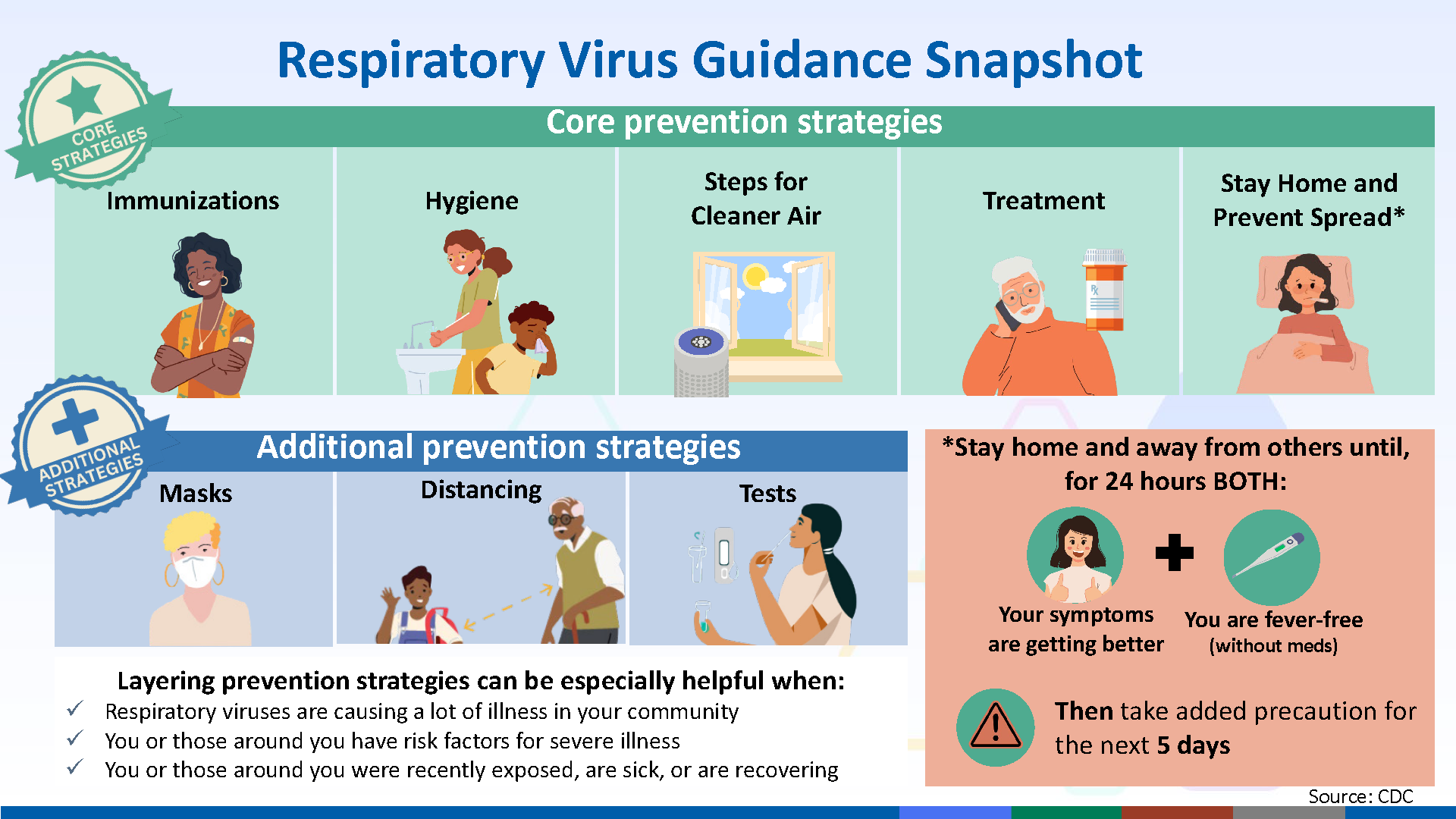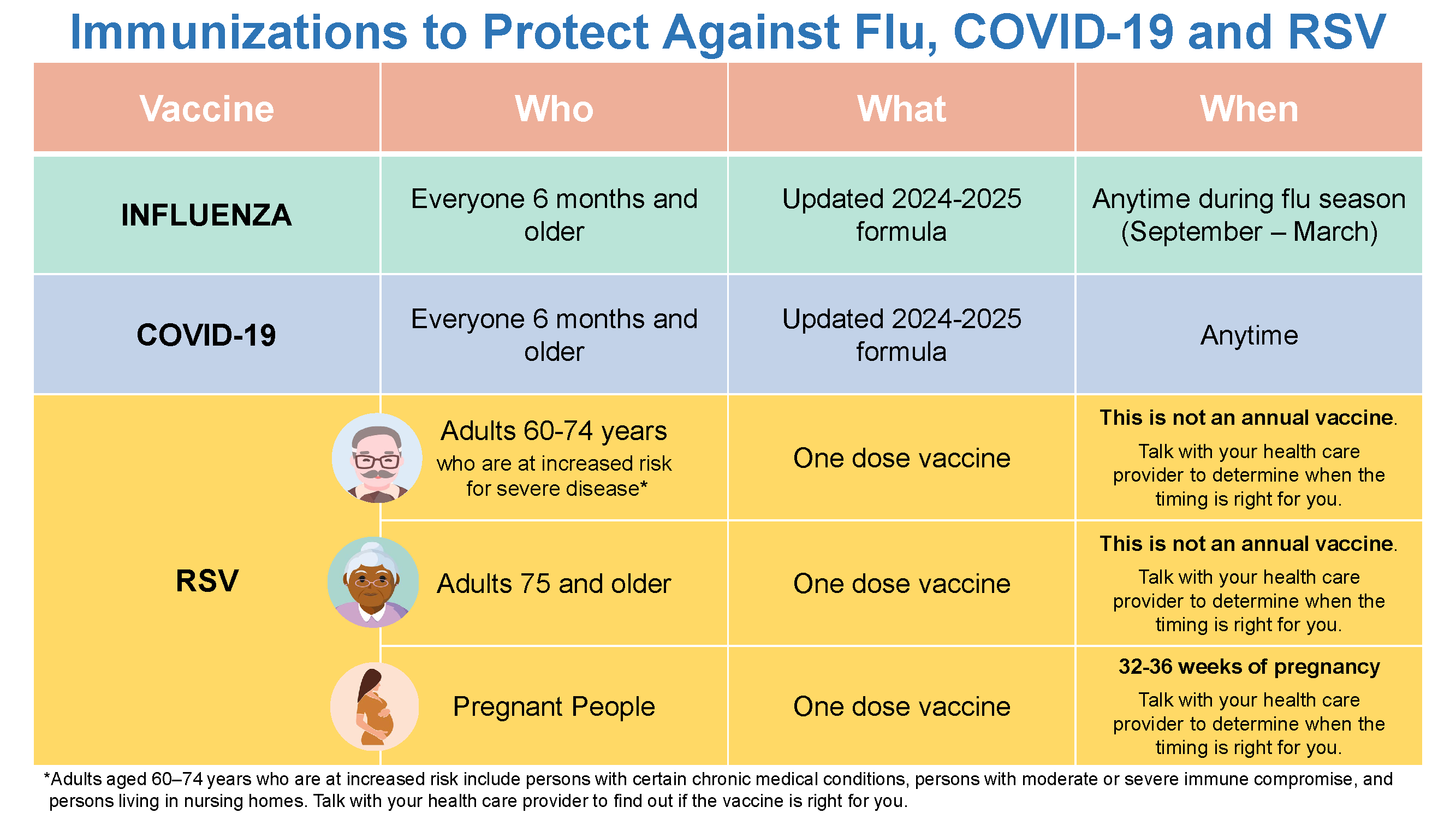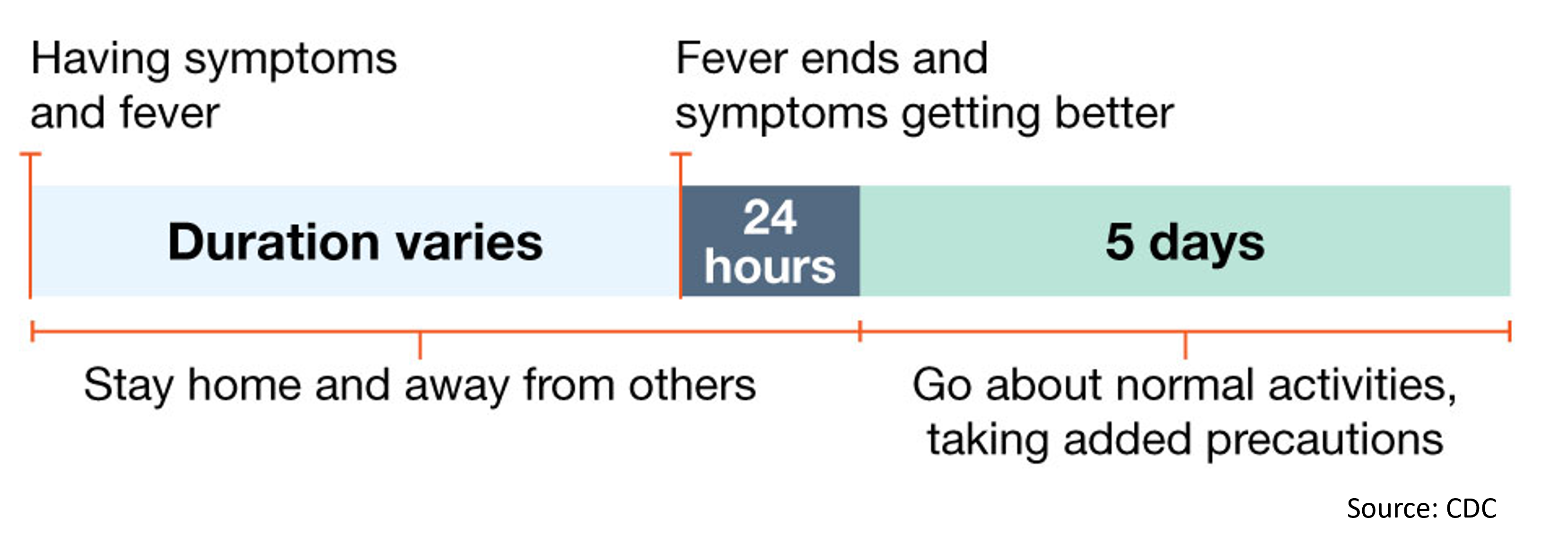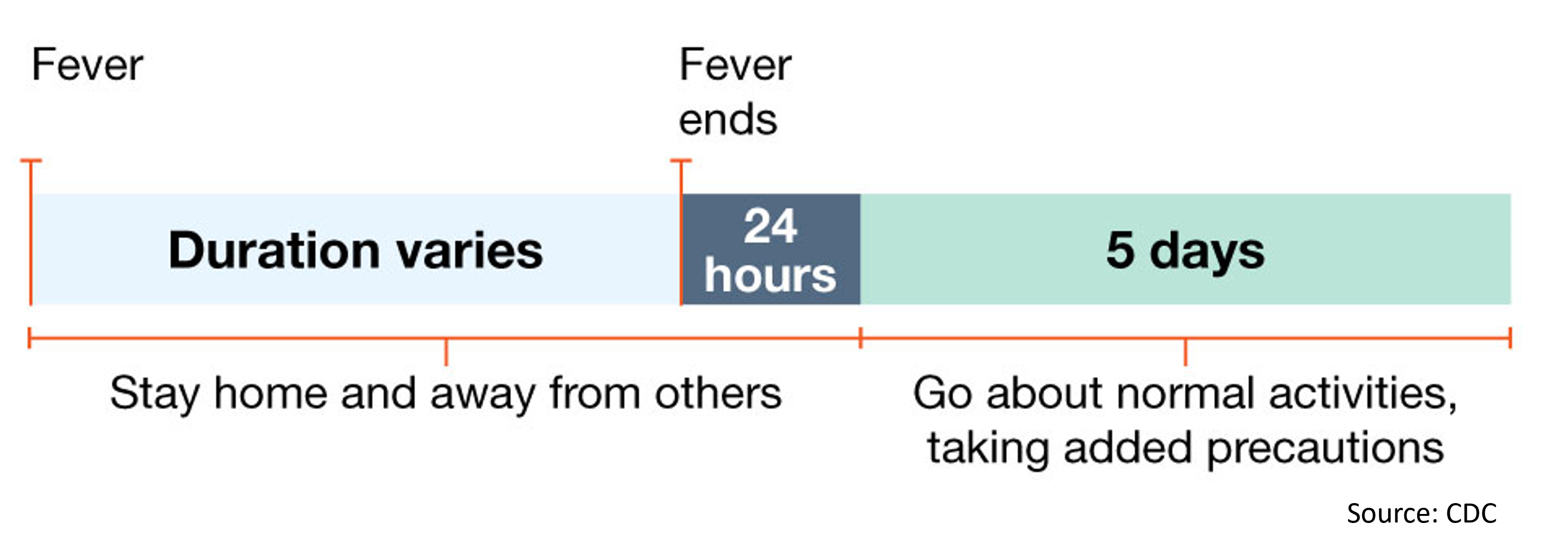Common Respiratory Viruses
On March 1, 2024, the CDC released updated Respiratory Virus Guidance that provides actionable recommendations for people with common viral respiratory illnesses, including COVID-19, Flu, and RSV. Standardizing this guidance helps you take immediate steps to keep your loved ones healthy when you’re sick, even if you don’t have a test available to identify which illness you may have.
PREVENT THE SPREAD
If you’re experiencing respiratory virus symptoms that aren’t better explained by another cause:
- Stay home and away from others (including people you live with who are not sick)
- You can go back to your normal activities when, for at least 24 hours, both are true:
- Your symptoms are getting better overall, and
- You have not had a fever (and are not using fever-reducing medication).
- When you go back to your normal activities, take added precaution over the next 5 days, such as taking additional steps for cleaner air, hygiene, masks, physical distancing, and/or testing when you will be around other people indoors.
- Keep in mind that you may still be able to spread the virus that made you sick, even if you are feeling better. You are likely to be less contagious at this time, depending on factors like how long you were sick or how sick you were.
- If you develop a fever or you start to feel worse after you have gone back to normal activities, stay home and away from others again until, for at least 24 hours, both are true: your symptoms are improving overall, and you have not had a fever (and are not using fever-reducing medication). Then take added precaution for the next 5 days.

Stay up to date with immunizations
As a core prevention strategy, immunizations help prepare your body to defend itself from viruses and severe illness. While getting vaccinated can reduce your chances of getting infected to some degree, its main strength is preventing severe illness and death. Additionally, more and more evidence suggests that the COVID-19 vaccine can lower your chances of developing Long COVID.

Frequently Asked Questions
While still posing a significant health threat to those at higher risk, COVID-19 health impacts are now increasingly similar to other respiratory viruses, like flu and RSV. As a result, the CDC has issued unified Respiratory Virus Guidance for COVID-19, flu, and RSV rather than guidance for each specific virus. This updated guidance was based on the following evidence:
- Effective vaccines against all three major viruses are now widely available:
- COVID-19 vaccines cut the risk of severe disease in half, and over 95% of hospitalized adults were not up to date with their COVID-vaccine in fall 2023.
- Flu vaccines similarly cut the risk of severe disease by close to half.
- For the first time in fall 2023, we had an immunization against respiratory syncytial virus (RSV) for older adults, pregnant people, and young children.
- Effective treatments are also widely available:
- Paxlovid cuts the risk of hospitalization by over half and the risk of death by even more (75%).
- Treatment of flu with antiviral medications can lessen symptoms and shorten the time you are sick by about a day. Starting antiviral treatment shortly after symptoms begin also can help reduce some flu complications.
- Population immunity to COVID-19 is high:
- >98% of U.S. population now has some protective immunity against COVID-19 from vaccination, prior infection, or both.
- As a result, far fewer people are getting seriously ill from COVID-19.
- Weekly hospital admissions for COVID-19 are down more than 75% from the peak of the initial Omicron wave in January 2022, and deaths are down by more than 90%. In 2022, COVID-19 accounted for more than 245,000 deaths. Last year, that number was around 76,000.
- Complications like multisystem inflammatory syndrome in children (MIS-C) are now also less common, and prevalence of Long COVID is also going down.
Symptoms may include but are not limited to:
- chest discomfort
- chills
- cough
- decreased appetite
- diarrhea
- fatigue
- fever
- headache
- muscle or body aches
- new loss of taste or smell
- runny or stuffy nose
- sneezing
- sore throat
- vomiting
- weakness
- wheezing
Step 1: Stay at home and away from others until your symptoms have improved and you have not had a fever, or used fever-reducing medication, for at least 24 hours.
Step 2: Resume normal activities, and use added prevention strategies over the next 5 days, such as taking more steps for cleaner air, enhancing your hygiene practices, wearing a well-fitting mask, keeping a distance from others, and/or getting tested if you will be around other people indoors.

Step 1: Stay at home and away from others until you have not had a fever and have not used-fever reducing medication for at least 24 hours.
Step 2: Resume normal activities, and use added prevention strategies over the next 5 days, such as taking more steps for cleaner air, enhancing your hygiene practices, wearing a well-fitting mask, keeping a distance from others, and/or getting tested if you will be around other people indoors.

Step 1: Stay at home and away from others until your symptoms are getting better, and stay better, for at least 24 hours.
Step 2: Resume normal activities, and use added prevention strategies over the next 5 days, such as taking more steps for cleaner air, enhancing your hygiene practices, wearing a well-fitting mask, keeping a distance from others, and/or getting tested if you will be around other people indoors.

If you develop a fever or you start to feel worse after you have gone back to normal activities, stay home and away from others again until, for at least 24 hours, both are true: your symptoms are improving overall, and you have not had a fever (and are not using fever-reducing medication).
Then take added precautions for the next 5 days, such as taking more steps for cleaner air, enhancing your hygiene practices, wearing a well-fitting mask, keeping a distance from others, and/or getting tested if you will be around other people indoors.

You may be contagious. For the next 5 days: take added precaution, such as taking additional steps for cleaner air, hygiene, masks, physical distancing, and/or testing when you will be around other people indoors. This is especially important to protect people with factors that increase their risk of severe illness from respiratory viruses.
This means that a person is starting to feel better, and the body is returning to normal after an infection. Symptoms can be used as simple indicators to help people make decisions about preventative strategies, such as how long to stay home or when to return to work or school. A respiratory virus infection can have many types of symptoms, some of which can last beyond when someone is infectious, such as a lingering cough. So having a single symptom or a combination of symptoms is not as important as the overall sense of feeling better and the ability to resume activities. Fever is mentioned as a specific symptom in the guidance because people tend to be more infectious when they have a fever.
No. The CDC’s Respiratory Virus Guidance is intended for a general audience and community settings and does not apply to healthcare settings. CDC offers separate, specific guidance for healthcare settings (COVID-19, flu, and general infection prevention and control) and Interim Guidance for Managing Healthcare Personnel with SARS-CoV-2 Infection or Exposure to SARS-CoV-2 that is not currently changing.
